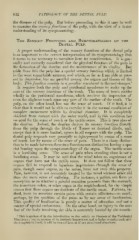Page 822 - My FlipBook
P. 822
832 PATHOLOGY OF THE DENTAL PULP.
the diseases of the pulp. But before proceeding to this it may be well
to examine the sensory Junctions of the pulp, with the view of a better
understanding of its symptomatology.
The Sensory Functions and Symptomatology of the
Dental Pulp.
A proper understanding of the sensory fimctions of the dental pulp
is so important to the correct interpretation of its symptomatology that
it seems to me necessary to introduce here its consideration. It is gen-
erally and correctly considered that the physical function of the pulp is
the formation of the dentine and the maintenance of its vitality. But
aside from this the pulp has a special sensory function which is limited
in the most remarkable manner, and M'hich, so far as I am able at pres-
ent to determine, has no parallel among the organs and tissues of the
body. This function consists in a 'peculiar resentment to thermal changes}
It requires both the pulp and peridental membrane to make up the
sum of the sensory functions of the tooth. The sense of touch resides
wholly in (he peridental membrane, which receives the impression of
even the slightest touch upon any part of the surface of the tooth. The
pulp, on the other hand, has not the sense of touch. If it had, it is
clear that it would not be able to exercise it in the normal condition of
complete encasement within its dentinal chamber. It is completely
shielded from contact with the outer world, and in this condition has
no need for the sense of touch or the tactile sense. This is true also of
the dentine. Indeed, the dentine derives its sensory function directly
from the pulp through the fibrils of Tomes or dentinal fibrils, and,
except that it is more limited, agrees in all respects Avith the pulp. The
dental pulp responds very promptly to injury—not by means of a sense
of touch, but by means of the sense of pain. There is a sharp distinc-
tion to be made between these two functions—a distinction having a spe-
cial bearing upon the symptomatology of the organ. The tactile sense
is a localizing sense. The sense of pain when standing alone is not a
localizing sense. It may be said that the mind takes no cognizance of
organs that have not the tactile sense. It does not folloM^ that these
organs fail to respond to injurious impressions through the sense of
]-)ain, though some organs, as the retina, have not even this property.
Pain, however, is not accurately located by the mind without other aid
than the mere sense of suffering. For instance, a patient can form no
conception as to whether a painful sensation proceeds from the stomach,
the transverse colon, or other organ in the neighborhood, for tlie simple
reason that these organs are destitute of the tactile sense. Patients, in-
deed, learn to associate certain pains with certain affections—as much,
perhaps, by the qualities of the pains as by any sense of localization.
This quality of localization is purely a matter of education and not a
matter of special endowment. On the other hand, an injury to the sur-
face of the body involving the skin is accurately located by the associa-
^ Tliis is spoken of in the introduction to the article on Diseases of the Peridental
jMenibrane ; Hut on account of its intrinsic importance, and a desire to make each arti-
cle complete in itself, it will be treated here as if not mentioned elsewhere.


